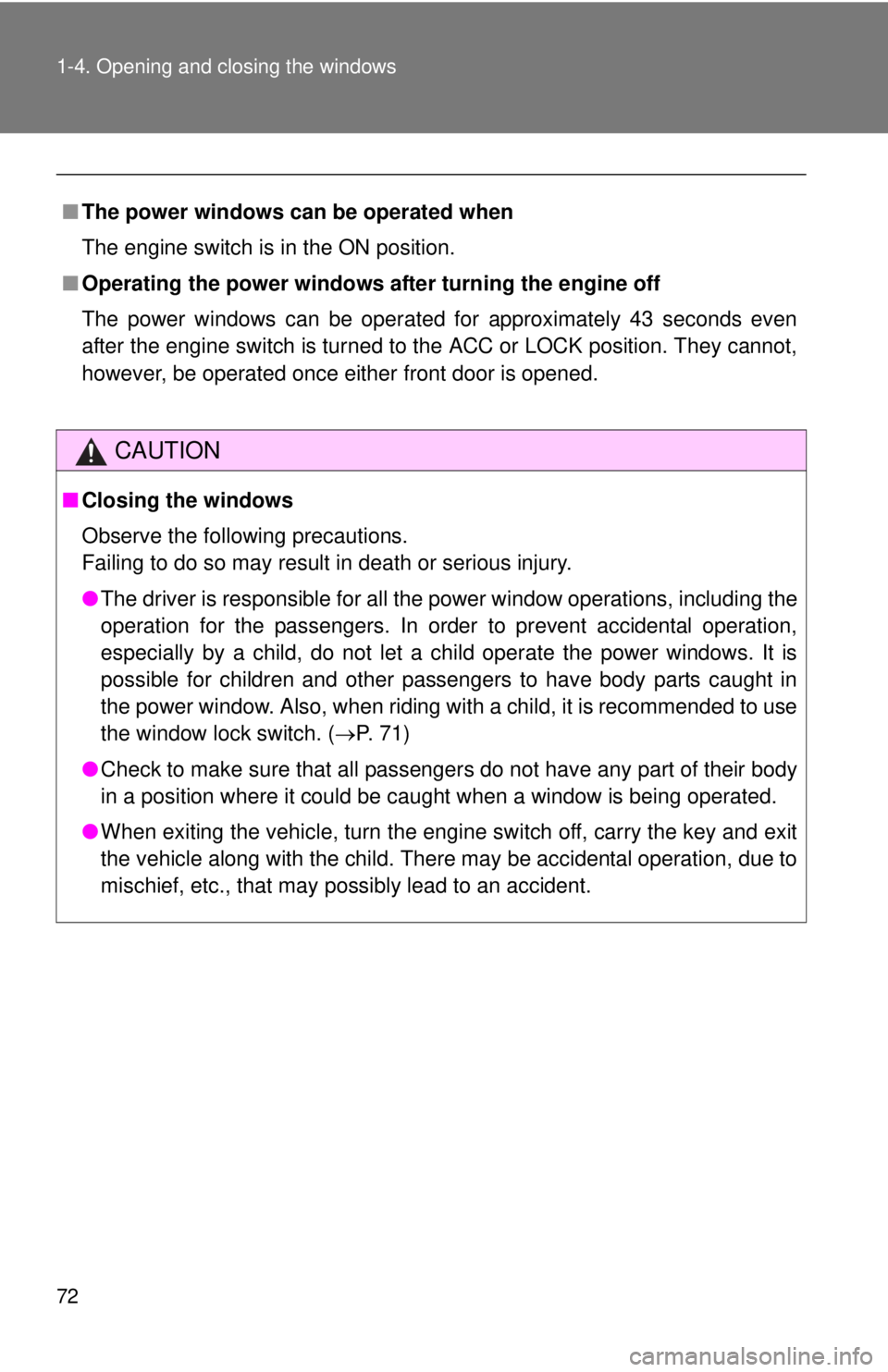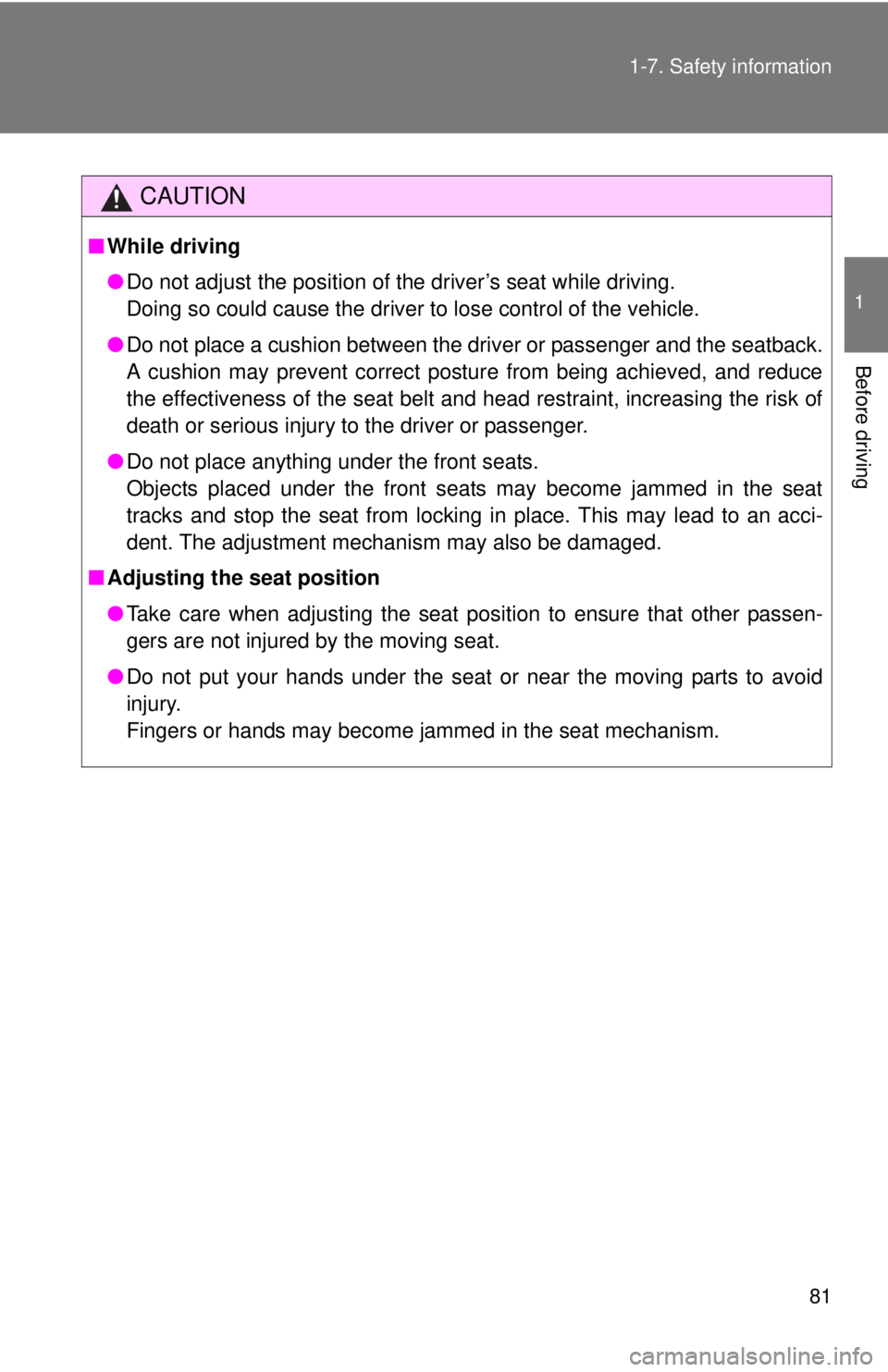Page 63 of 590
63
1
1-3. Adjustable components (seats, mirrors, steering wheel)
Before driving
Steering wheel
CAUTION
■Caution while driving
Do not adjust the steering wheel while driving.
Doing so may cause the driver to mishandle the vehicle and an accident
may occur resulting in death or serious injury.
■ After adjusting the steering wheel
Make sure that the steering wheel is securely locked.
Otherwise, the steering wheel may move suddenly, possibly causing an
accident and resulting in death or serious injury.
The steering wheel can be adjust ed to a comfortable position.
Hold the steering wheel and
press the lever down.
Adjust to the ideal position by
moving the steering wheel
horizontally and vertically.
After adjustment, pull the lever
up to secure the steering
wheel.
Page 71 of 590
71
1
Before driving
1-4. Opening and closing the windows
Power windows
Lock switchPress the switch down to lock
passenger window switches.
Use this switch to prevent chil-
dren from accidentally opening or
closing a passenger window.
The power windows can be opene d/closed using the following
switches.
Driver’s power window switches
Closing
Opening
One-touch opening (driver’s
window only)
*
*
: To stop the window partway, operate the switch in the oppo-
site direction.
Front and rear passenger’s power window switch
Closing
Opening
Page 72 of 590

72 1-4. Opening and closing the windows
■The power windows can be operated when
The engine switch is in the ON position.
■ Operating the power windows af ter turning the engine off
The power windows can be operated for approximately 43 seconds even
after the engine switch is turned to the ACC or LOCK position. They cannot,
however, be operated once either front door is opened.
CAUTION
■ Closing the windows
Observe the following precautions.
Failing to do so may result in death or serious injury.
●The driver is responsible for all the power window operations, including the
operation for the passengers. In order to prevent accidental operation,
especially by a child, do not let a child operate the power windows. It is
possible for children and other passengers to have body parts caught in
the power window. Also, when riding with a child, it is recommended to use
the window lock switch. ( P. 71)
● Check to make sure that all passengers do not have any part of their body
in a position where it could be caught when a window is being operated.
● When exiting the vehicle, turn the engine switch off, carry the key and exit
the vehicle along with the child. There may be accidental operation, due to
mischief, etc., that may possibly lead to an accident.
Page 73 of 590
73
1
1-4. Opening and closing the windows
Before driving
Back window (vehicles with sliding type)
■Closing the back window
Make sure that the back window is securely closed after closing it.
CAUTION
■While driving
Keep the back window closed.
This not only keeps personal belongings from being thrown out, but also pre-
vents exhaust gases from entering the vehicle.
The back window can be opened and closed using the lock release
lever.
Open/close
Push the lock release lever
and slide the back window.
Page 80 of 590
80
1-7. Safety information
Correct driving posture
Drive in a good posture as follows:
Sit upright and well back in
the seat. (P. 4 5 )
Adjust the position of the
seat forward or backward to
ensure the pedals can be
reached and easily
depressed to the extent
required. ( P. 45)
Adjust the seatback so that
the controls are easily oper-
able.
Adjust the tilt and telescopic
positions of the steering
wheel downward so the air-
bag is facing your chest.
( P. 63)
Lock the head restraint in
place with the center of the
head restraint closest to the
top of your ears. ( P. 53)
Wear the seat belt correctly.
( P. 57)
Page 81 of 590

81
1-7. Safety information
1
Before driving
CAUTION
■
While driving
●Do not adjust the position of the driver’s seat while driving.
Doing so could cause the driver to lose control of the vehicle.
● Do not place a cushion between the driver or passenger and the seatback.
A cushion may prevent correct posture from being achieved, and reduce
the effectiveness of the seat belt and head restraint, increasing the risk of
death or serious injury to the driver or passenger.
● Do not place anything under the front seats.
Objects placed under the front seats may become jammed in the seat
tracks and stop the seat from locking in place. This may lead to an acci-
dent. The adjustment mechanism may also be damaged.
■ Adjusting the seat position
●Take care when adjusting the seat position to ensure that other passen-
gers are not injured by the moving seat.
● Do not put your hands under the seat or near the moving parts to avoid
injury.
Fingers or hands may become jammed in the seat mechanism.
Page 105 of 590
105
1-7. Safety information
1
Before driving
■
Using the seat belts
Seat belts equipped with a
child restraint locking mecha-
nism (ALR/ELR belts except
driver’s seat belt) (P. 57)
■ Using the top tether strap
Access Cab models (vehicles without rear seats)
Anchor bracket (for top tether
strap)
Anchor bracket is provided
for passenger seat.
Page 110 of 590
110 1-7. Safety information
Type BWiden the gap between
the seat cushion and
seatback slightly.
Latch the buckles onto
the LATCH anchors.
If the child restraint has a
top tether strap, the top
tether strap should be
latched onto the top
tether strap anchor.
For owners in Canada:
A symbol on a child restraint sys-
tem indicates the presence of a
lower connector system.
Installing child restraints using a seat belt (child restraint lock function belt)
■ Rear-facing (vehicles without rear seats) — Infant seat/con-
vertible seat
Never install a rear-facing child restraint. Your vehicle is not
designed to carry an infant.
■ Rear-facing (vehicles with rear seats) Infant seat/convert-
ible seat
Place the child seat on the rear
seat facing the rear of the vehi-
cle.
Canada
only